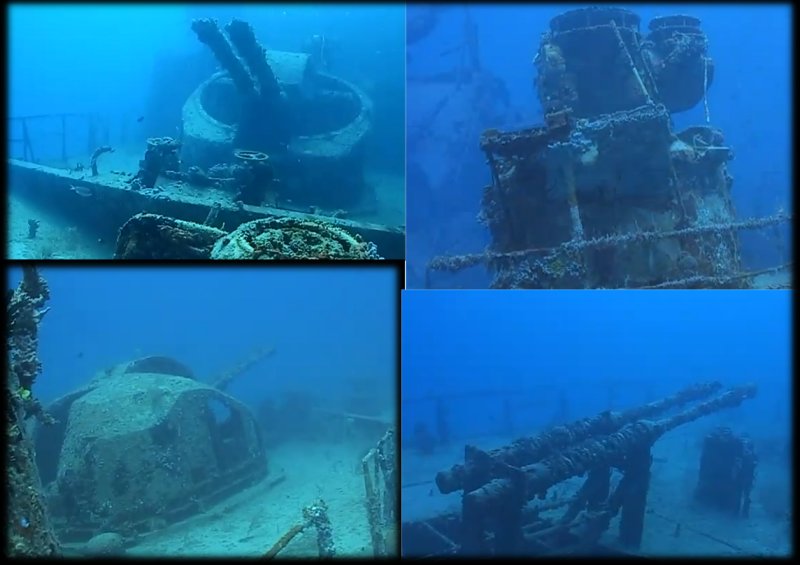Diving - The adventure continues!
Diving Cuba 2012
Part of the reason for choosing a summer holiday in Cuba was to experience diving in the Caribbean.
Obviously as it was part of a family holiday I wasn’t going to get a full week’s diving, but I managed to book two days (4 dives) with Baracuda in Veradero.
Veradero isn’t the creme de la creme of Cuban diving, but it has its appeal. This link provides some more details on diving in Cuba.
The one dive I really wanted to do was on the “Russian Destroyer”. Much like HMS Scylla off Plymouth, the patrol boat (it’s too small to be a Destroyer) was sunk as an artificial reef and diving attraction.
There are two big differences to the Scylla. Firstly, the patrol boat is intact, with all its guns and missile launchers and so has more interesting things to see on the outside and secondly it’s in 30m of crystal clear water, so virtually as soon as you’re underwater you can see the outline of the wreck beneath you.
But I’m getting ahead of myself. A bus picked me up from my hotel (well it did at the second attempt, the first day I was supposed to go, we failed to find each other!) and drove me the short distance to Barracuda’s dive centre in the marina area (the numerous Catamarans and game fishing boats also go from here).
They checked our certification and handed out, mostly Scubapro, equipment (a few had brought their own, I’d only bought a mask, my camera and dive computer) which was fine for the warm water, easy diving we were to do.
We quickly assembled it onto a tank and boarded the boat and headed out to sea. The boat was roomy (there was about 14 people on the boat the first day, plus some guides) and modern.
After about 45 minutes, we kitted up and the boat stopped. We dropped off the stern in groups of 6 (the odd divers were doing a PADI Deep Course with the English instructor in their Group) and start to descend down the anchor line.
Very soon we could see the wreck beneath us, divers stacked beneath us from the other group, but we were the only boat here.
We followed our guide around the boat, but stupidly I’d not set up my camera correctly, so all I could do was review the photos I’d taken on the beach the previous day! So, this photo isn’t mine, but rest assured it was a great dive and lived up to my hopes, with both the wreck and a decent number of fish to see.
Back on the surface, we climbed the ladder back onto the boat (after a 3 minute safety stop at 5 metres which afforded us the chance to take in the full wreck, clearly visible 20m below) and excitedly chatted about the dive, whilst we moved out regs and BCDs over to fresh tanks.
After about 20 minutes, we reached the Cayo Piedras reef. At first it seemed a bit of a dull dive, at around 10M maximum and little to see but sand, but then we reached a rocky outcrop, alive with fish and this continued on for some while.
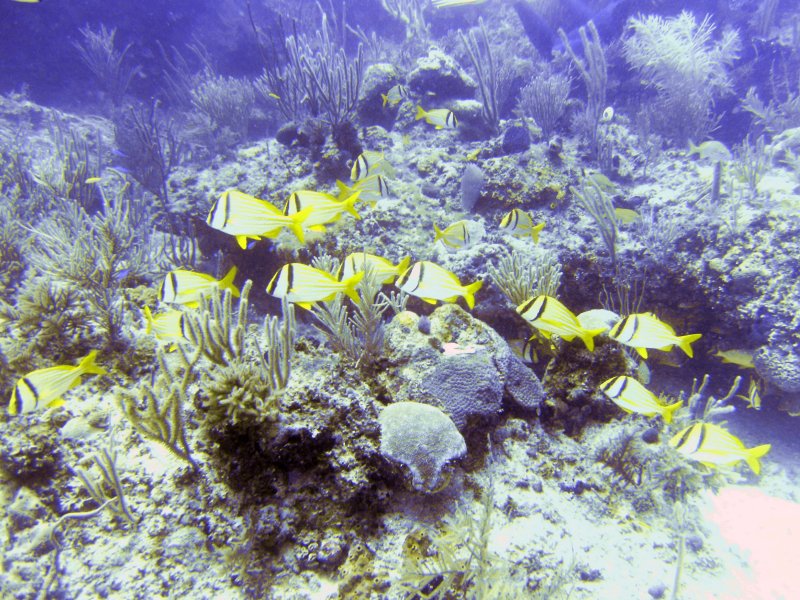
Porkfish galore
My keen-eyed buddy (A German named Hanno, who’d been backpacking around Cuba for 3 weeks) spotted a Barracuda a little way off and we swam over to see it.
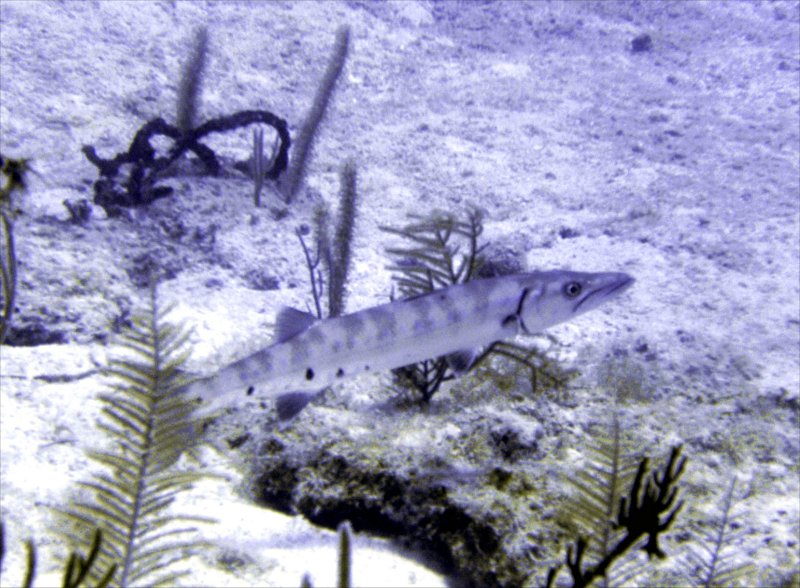
Lone Barracuda
There were Congers, Lion Fish,Grunts (blue striped and the colourful Porkfish), Jawfish (who hid in holes on the seabed and pop out their heads to eat), Angel and the similar Butterfly fish, what looked like Wrasse and smallish Groupers and numerous other fish species which I couldn’t identify, as well as abundant coral.
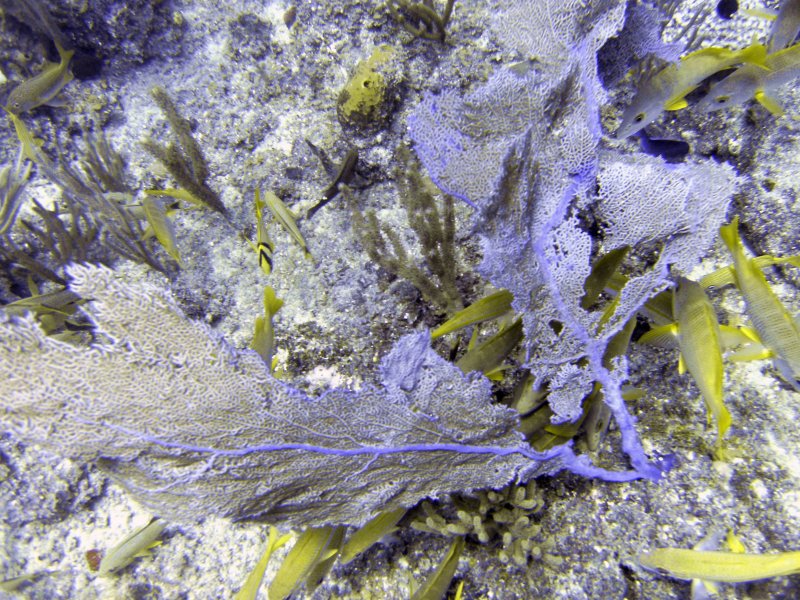
Not just fish
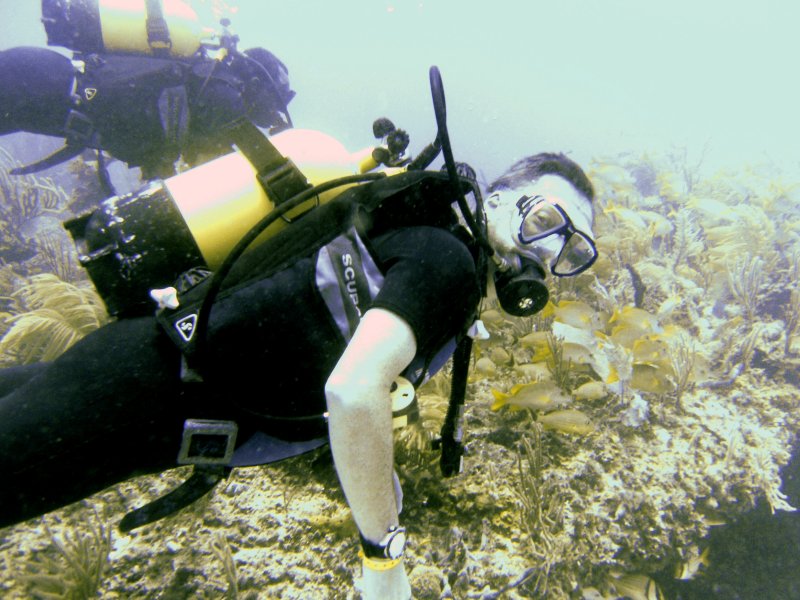
Does it get better than this?
A number of divers spotted a school of large Barracuda, but sadly I didn’t see them.
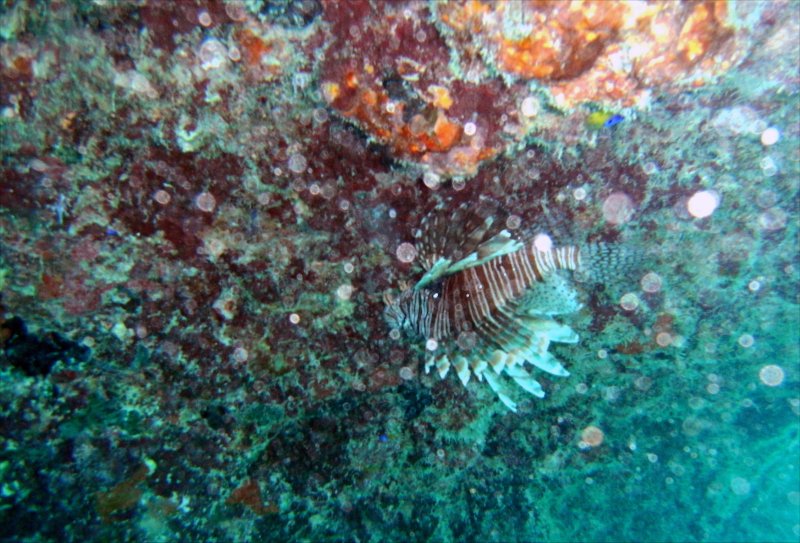
Lionfish abound, this one hides under an outcrop...
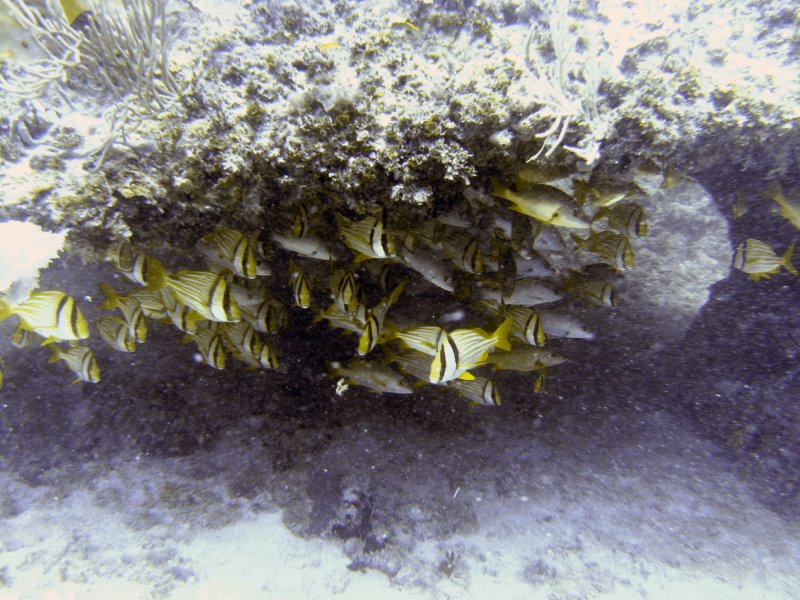
...as do other fish, there are a lot of predators out there.
All in all, the camera debacle notwithstanding, this was a great days diving, with warm waters (27C at 30M) and outstanding visibility.
The next day I was back for another two dives, this time both on Wrecks, but ones I knew nothing about.
The first was, for me, the highlight of my short diving experience in Cuba.
The Sletra is the rear superstructure of a tanker that, supposedly, broke up and sank.
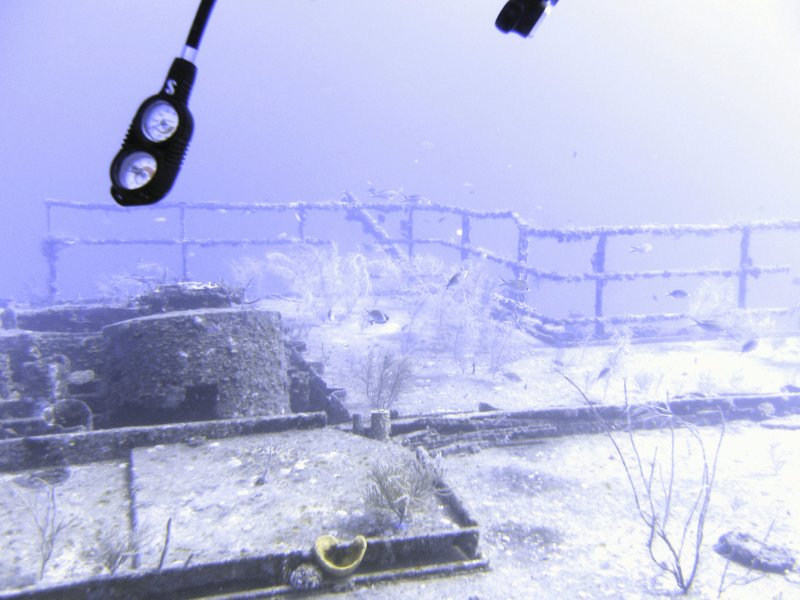
Lots of the wreck is fairly intact and vis is great
The superstructure sits vertically on the seabed and as we descended the shotline it was apparent that it’s quite a large structure. It’s a bit like swimming around a 4 story buliding on the sea bed, although there on the seabed at the stern is the screw.
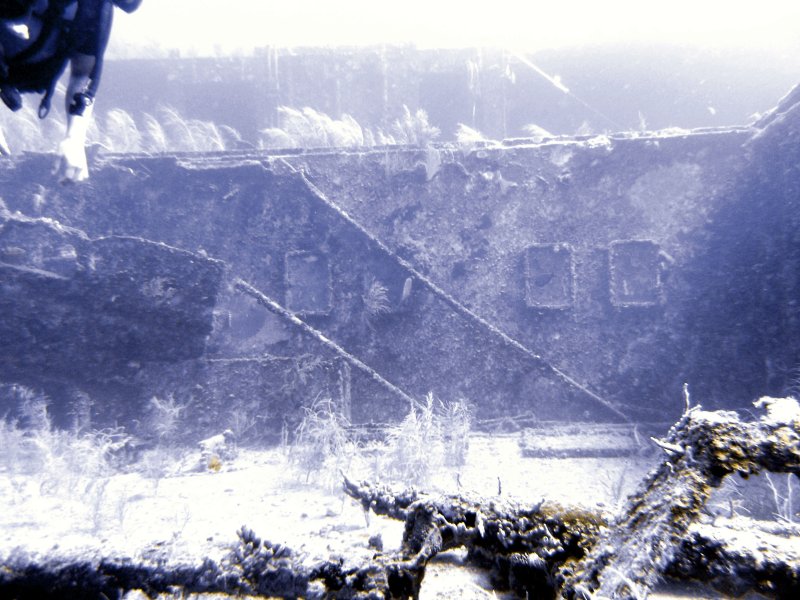
Flight of stairs and windows
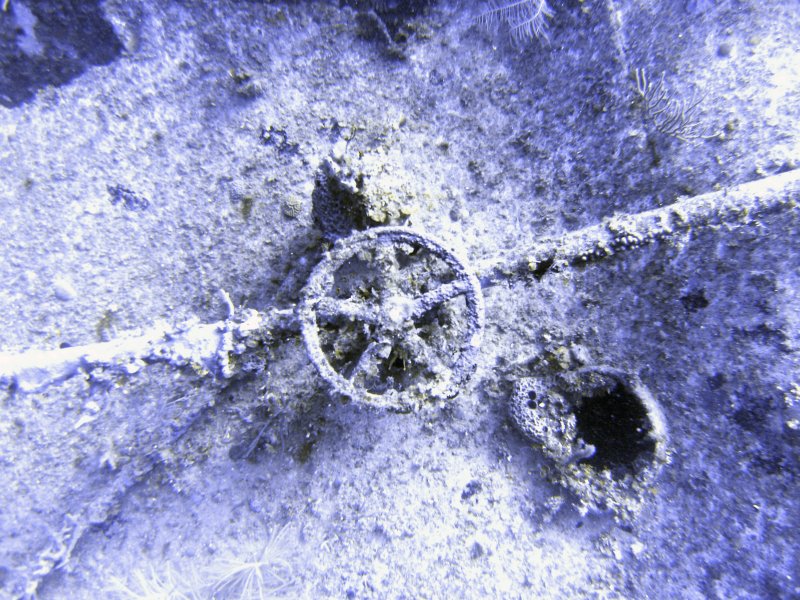
Controls are frequently still in place
Many fittings are still in place, including hand rails and control for pumps and the whole wreck is alive with sealife, include many large Lionfish, Blue Snappers and shoals of Grunts.
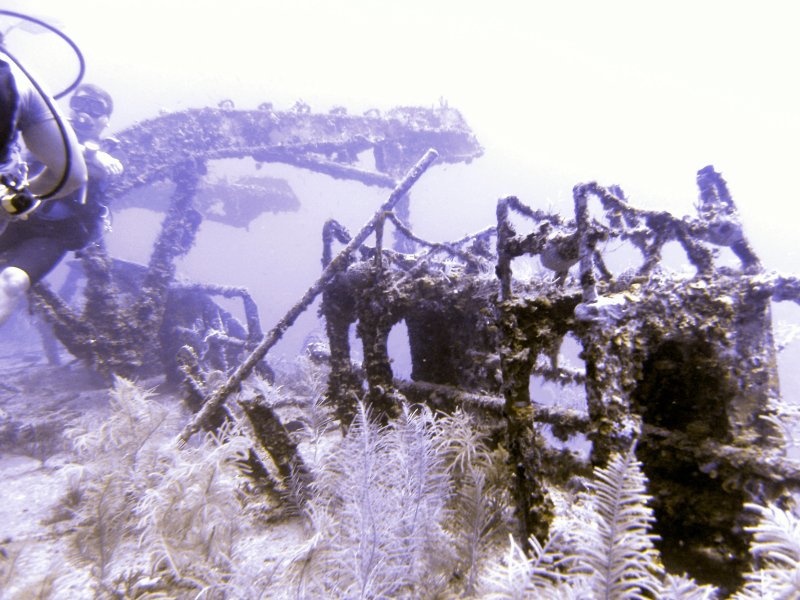
Lifeboat davits on the upper decks
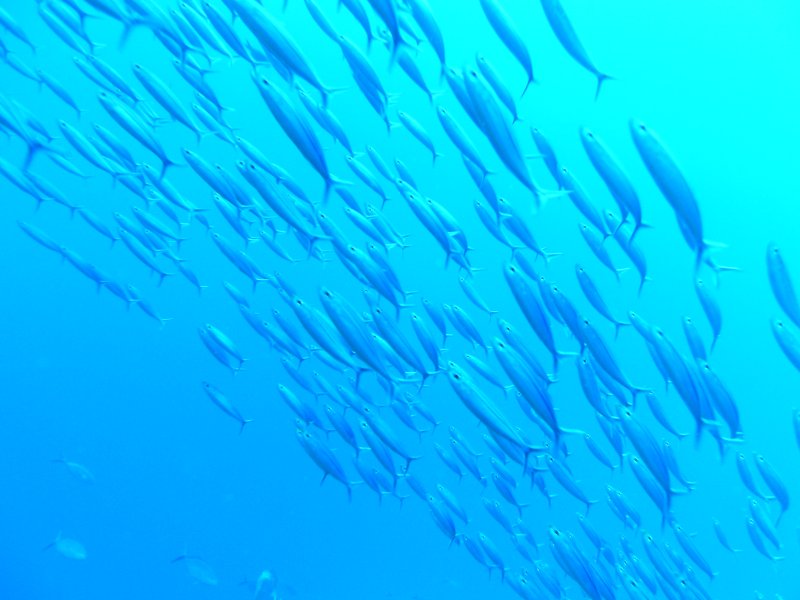
Shoals of fish rush by
Swimming up and down the decks, through a few of the openings and around the remains of the hull was a great dive, but all too soon we were heading back to the shotline and surfacing.
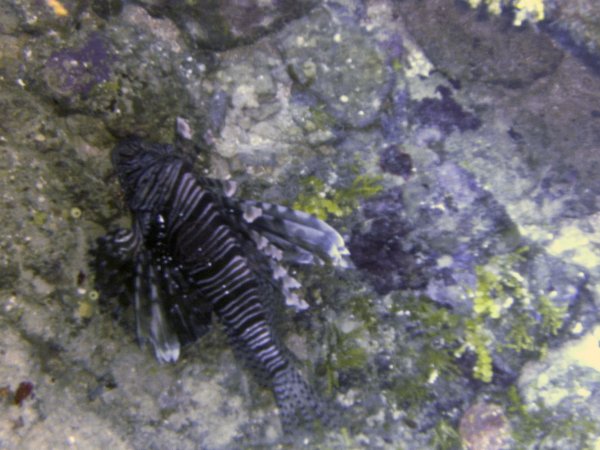
Lots of BIG Lionfish
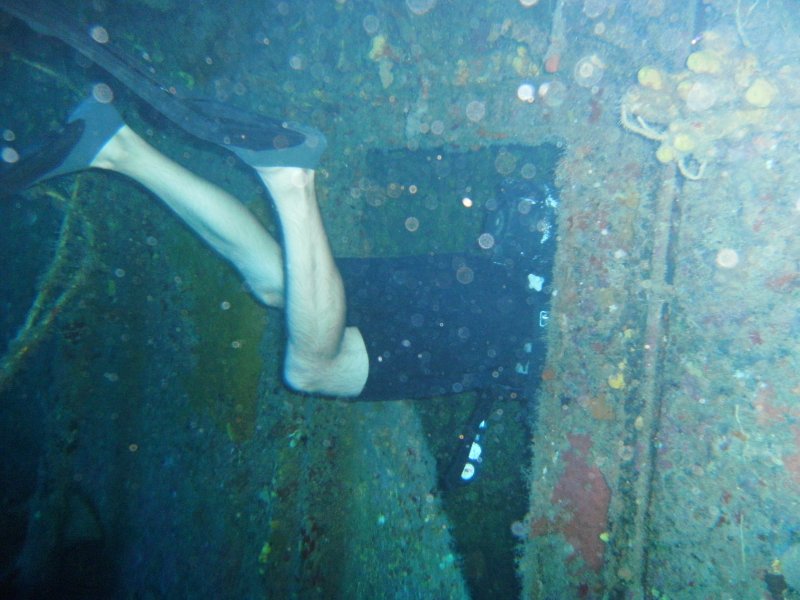
Some simple swimthroughs
Hanging on the shotline for a 5m safety stop, we could see the wreck beneath us and the next wave of divers exploring it.
The second dive was on a wreck called the Neptuno. At only 10m or so, this was a gentle second dive enlivened by the sheer volume of sea life..
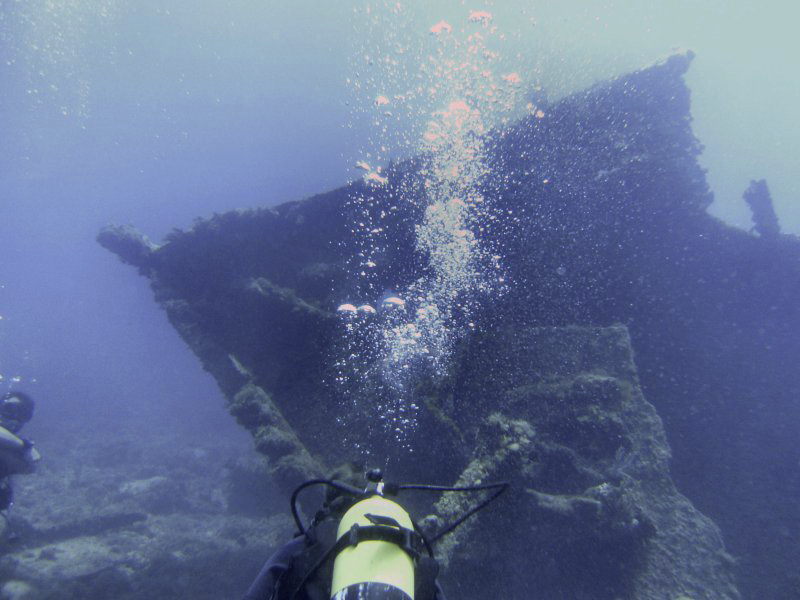
Bow one of the few parts still recognisable
Most of the wreck is very broken up. The twin boilers sit on the seabed, clearly what they are, and the bow remains relatively intact, but the rest is just a broadly scattered collection of old ship junk.
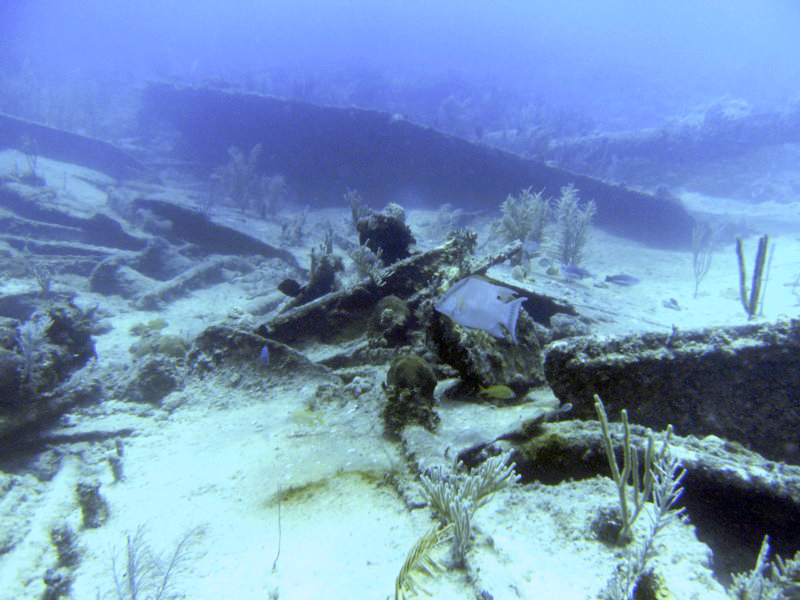
Most of the wreck is, well, wreckage
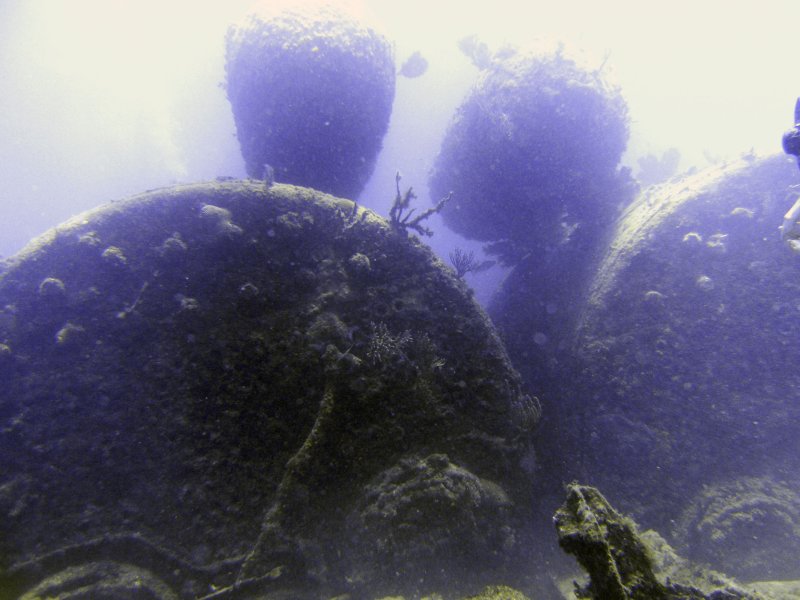
Twin boilers sit on seabed as a handy landmark
As I said, though, the good thing about this relatively shallow wreck is that there’s plenty of life.
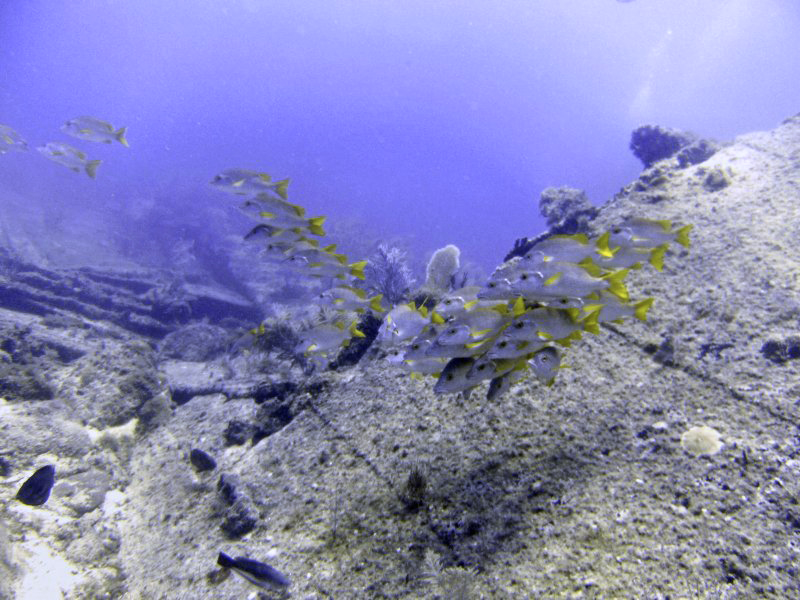
Fish love this wreck
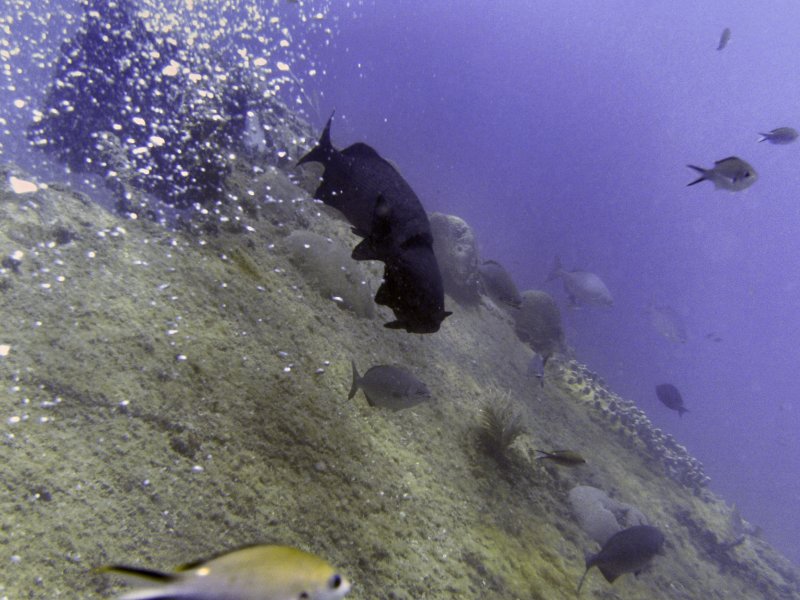
Grunts (I think)
We spotted a Trumpetfish, Blue Tan, a Porcupinefish and big shoals of Grunts of various kinds.
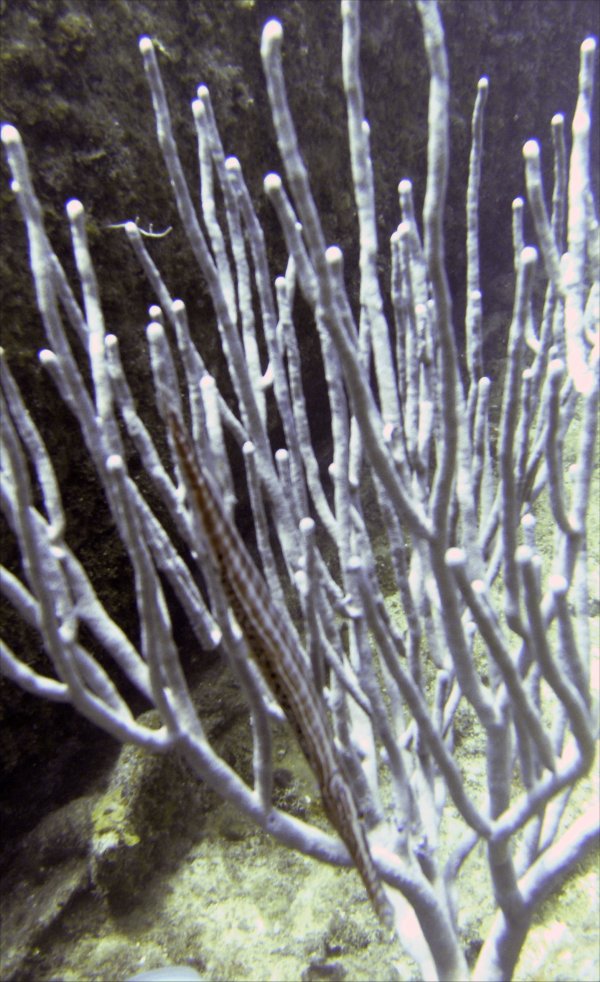
Pipefish hides (and feeds) amongst coral
Not the most exciting wreck to explore, but great for divers who enjoy sealife. It says a lot that this dive was probably the least exciting of the 4 I did as in isolation it would have counted as a great dive.
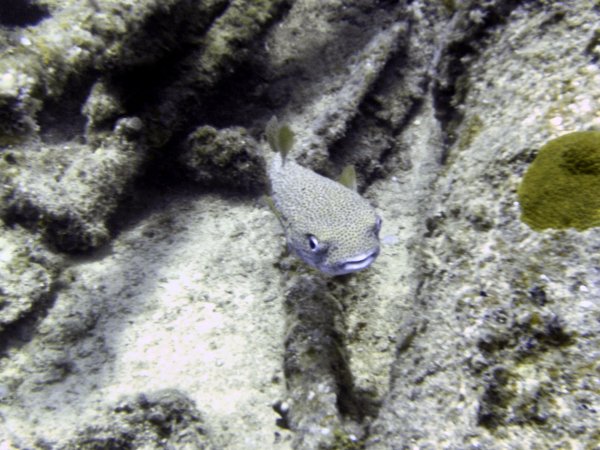
Porcupinefish with a friendly face
Overall, diving in Varadero was a highly enjoyable experience. Barracuda’s boat was well equipped, roomy and comfortable. The guides good at showing us the highlights and finding fish species and pleasant company on the boat, as were the other divers I dived with.
The diving equipment we were loaned wasn’t possibly as good as you might want for yourself (and a few divers had brought all their own equipment), but it was good quality, mainstream kit in reliable working order and I didn’t see anyone have any issues with it on any of my dives.
I’d happily dive with them again, although having had my appetite whetted by the diving off Varadero, I’d be tempted to take in some of the excellent diving elsewhere around Cuba, which I’m told puts this firmly in the shade!
From a personal point of view, it was lovely diving in a group with such great visibility as you could pause to look at something or take a photo an easily find your buddy even if they’d swum on a little way. You also get a much better perspective of what you’re diving on what the viz is so good and whilst I’ve rarely been cold in my drysuit (when used with an undersuit) it’s very enjoyable to dive in a shorty 2mm in 30m and feel warm!
PADI Wreck Diving Spec, Plymouth, August 2012
After an abortive attempt to dive Swanage Pier (it was a beautiful day, but blowing a storm!) with my BSAC club, I contacted Plymouth Dive Centre again and arranged to travel back on the 19th August to carry out the final, penetration, dive on HMS Scylla to finish my PADI Wreck Diver course.
The weather was lovely when I drove down and stayed again at the excellent Barbican Reach Guesthouse, but as I stepped out of the front door the next cloudy morning it started to pour with rain.
It proved to just be a heavy, prolonged, shower and by the time we kitted up and headed to the rib it was simply cloudy with the odd spot of rain.
The sea was quite choppy heading across the Sound, but when we reach HMS Scylla the surface was like mill pond.
We descended the shot line, but any hopes of crystal clear visibility were dashed; it was worse than my previous visit.
The final dive required us carrying out a penetration of the ship, laying line as we went and then returning the way we came, recovering the line as we exited.
There were two of us and I went in first. I tied off the reel on the outside and then looped the line a few times around a bracket just inside, as you're supposed to.
It was dark in there and, although Scylla has many cut-outs to make it fairly safe to dive on, you couldn't really see light from them until you were alongside them.
Using my torch and the reel, I was soon short on hands, but did a fair job of laying my line, keeping it low and tying it off fair regularly. Graham, the instructor, appeared from a cut-out and indicated it was time to turn around and head back out after a few minutes and I did so. There wasn't much silt behind me (I was glad to see!), but it was still dark. Fairly quickly I had tangled the line around the spool as there was a bit of a current running making it hard to spool the reel in as fast as I went down the line.
After a few seconds of trying to untangle it I decided to follow the course advice and simply gather the line around the reel and sort it out later. Wasting time inside a wreck trying to clear a jammed or tangled reel is not a smart move.
I got out okay and handed the tangled mess to Graham and my course-mate repeated the action, having a bit more luck (or skill) with his reel, whilst I and a Dive Master hung around the entrance in the top of the bow.
We still had plenty of air at this point, so Graham led us back into the opening and we followed each other through the main corridor of the ship, known as Hollywood Boulevard.
If you've never been inside a wreck before it's an exciting, yet scary experience.
Swimming through the fairly narrow corridor in these conditions, I was aware that I could very easily veer off into one of the numerous compartments leading off it and, if I stirred up the silt, not be able to easily find my way back into the corridor. It focusses your mind on keeping the person in front in sight, I can tell you!
We came out of the starboard side near the rear, checked air and then swam back through another section.
As we popped out of the cut-out on the port side, I found myself rising up quite quickly and my head came into contact with the soft growth on the roof of the companion way along the side of the ship.
I dumped the air on my BCD and drysuit, but didn't have that much and was still positively bouyant. The Dive Master was behind me and waited whilst I pulled myself down from the ceiling and swam along, having now lost contact in the murk with Graham and my fellow student. I checked in a few of the cut-outs, looking for their torches, but saw nothing so continued along the side of the ship until I met Graham looking for me at the bow.
We then started to surface, but as we reached the 5m stop, but feet seemed to develop a mind of their own, swinging me up and to one side. I dumped the remaining air to little effect and Graham saw I was having trouble and held my legs down as I tried to clear the last little bits from my suit. Finally I got stable enough for us to complete our 3 minute safety stop and we surfaced and returned to the rib.
It was then that I realised why I'd had so much trouble with buoyancy towards the end of the dive.
I've got a Mares BCD with integrated weights and as I went to pass the second up to the helper on the boat I found it was missing, I must have snagged it on the ship as (or just before) I exited the cut out and was immediately down 4KG of my 12 I was carrying.
It was reassuring in a way that I had an explanation for the sudden loss of control I'd never experienced before, but I was out of pocket for the weight pocket and 4KG of lead! Another lesson learnt about wreck diving, there are hazards waiting for you everywhere!
Back on the rib, our journey back was greeted with sunshine, but with a 200 mile journey home I decided not to hang around for a late afternoon dive. Photos were taken for my cert card and farewells made and I headed back up the A303 for home.
I was pleased to have finally got the Wreck Spec completed. It was useful training and experience and whilst I probably won't put it into practice much in Scapa Flow, it will improve my confidence around wrecks.
No photos, too busy in the low viz to risk pausing to take photos!
Read some more of my diving experiences, by clicking the icons below.

